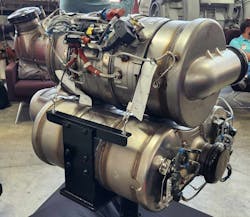COLUMBUS, Indiana—To comply with 2027 emissions regulations, new powertrains must make performance compromises.
Despite the added weight and backpressure of a larger aftertreatment system, Cummins' latest X15 engine still touts characteristic robustness and improved fuel economy. The 15-liter diesel engine is built to comply with EPA and CARB regulations and is a major step in the company's fuel-agnostic engine platform, HELM.
“What you’re going to see is, because we’re investing in these new platforms—they’re state-of-the-art platforms, very efficient, very low friction—we’re able to both deliver fuel economy and lower NOx,” Jim Nebergall, executive director of market strategy for Cummins, told journalists before a walkaround of the new diesel engine at the Cummins Columbus Engine Plant. “That’s unheard of; historic.”
A significant part of the new X15’s fuel efficiency improvements comes from piston friction reductions, block cooling optimization, and weight reductions. Meanwhile, the aftertreatment system has expanded to meet some of the most stringent emissions requirements in decades.
See also: Heavy-duty engine trends to watch in 2024
Major engine changes
Ever-improving design and analysis technology allowed Cummins engineers to make minute engineering improvements throughout the engine. Some of the greatest improvements were in the engine block and pistons.
The engine block layout is roughly 50 lbs. lighter. Stiff but light, the new block is noticeably shorter than the previous X15’s. Piston friction is reduced, and improvements in computational fluid dynamics allow for optimized block cooling. Overall, pressure loss is about a third lower than the last X15—from 63 kPa down to 20 kPa.
The engine now utilizes a true dual overhead camshaft design. Cummins’ previous dual overhead camshaft configuration dedicated one camshaft to just actuating fuel injectors.
The engine also moved from an open crankcase to a closed one for better emissions performance. The closed crankcase uses a maintenance-free crankcase ventilation breather, allowing the engine to feed crankcase gases to its aftertreatment system.
A new engine control unit, CM355, helps the engine meet new regulatory cybersecurity requirements. The ECM is also built to support future technology or regulations.
A composite valve cover and composite oil pan help to reduce the engine’s overall weight.
Smaller pistons
The new X15’s pistons are now more compact, reducing overall engine weight and block height. The new piston has a smaller bowl and shorter height. Its pin is also closer to the firing deck, reducing friction.
Revised fuel pump
The new engine’s fuel pump aims to resolve some of the company’s previous fuel pump failures.
“We’ve now engineered them out completely,” Tom Marsh, VPI program leader for the EPA27 X15, told media.
In addition to more compact design, the pump is now fuel lubricated rather than oil lubricated. The pump’s fuel pistons are located on opposite sides, helping to better balance the camshaft for enhanced robustness.
More sustainable fuel filter
New fuel filters to complement the X15 need significantly less waste disposal, thanks to a reusable housing.
A unique and light reusable plastic filter housing means that a technician may only need to drain old oil and replace the filter media. A spout on the bottom of the housing allows a technician to drain the oil before removing the housing. The filter media itself is easy to remove and replace.
Stronger aftertreatment
To comply with 2027 EPA emissions requirements, the aftertreatment system utilizes more catalyst volume through a dual selective catalytic reduction system.
Cummins also added heaters to the aftertreatment system to boost catalyst performance on demand. Regulations require the system to remain below set emissions levels under any condition, even when a truck is bobtailing, where the low load does not sufficiently heat the system’s catalyst material.
The heaters, a pattern of resistive wire running roughly 5kW, allow the aftertreatment system to heat the catalyst material wherever conditions require. To power the heater, the engine now uses a belt-driven 48-volt alternator.
This article was originally published on FleetOwner.com.
About the Author
Jeremy Wolfe
Editor
Editor Jeremy Wolfe joined the FleetOwner team in February 2024. He graduated from the University of Wisconsin-Stevens Point with majors in English and Philosophy. He previously served as Editor for Endeavor Business Media's Water Group publications.





